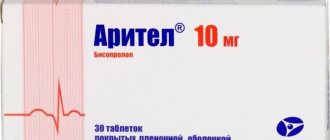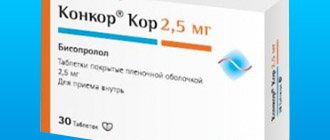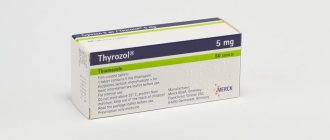Pharmacological properties of the drug Olanzapine
An antipsychotic with a wide spectrum of pharmacological action due to its antagonistic effect on various receptors. Olanzapine has an affinity for serotonin (5-HT2A/C, 5-HT3, 5-HT6), dopamine (D1, D2, D3, D4, D5), muscarinic (M1-5), adrenergic (α1), histamine (H1) receptors. Affinity for serotonin receptors is higher than for dopamine receptors. Selectively reduces the excitability of mesolimbic neurons, having minimal effect on the reticular formation involved in providing motor functions. Olanzapine is well absorbed when taken orally; food intake does not affect its absorption. The maximum concentration in the blood plasma is reached after 5–8 hours. At a concentration of 7–1000 ng/ml, 93% of olanzapine is bound to plasma proteins, mainly albumin and α1-acid glycoprotein. When taken at a dose of 1–20 mg, the kinetics of olanzapine are linear. Metabolized in the liver by conjugation and oxidation. The main metabolite detected in the blood is 10-N-glucuronide, which does not penetrate the BBB. The isoenzymes CYP 1A2 and CYP 2D6 of cytochrome P450 take part in the formation of N-desmethyl and 2-hydroxymethyl metabolites. Both of these metabolites have significantly less pharmacological activity; clinical effectiveness is due to the parent compound. The half-life of olanzapine is 33 hours (21–54 hours). Up to 57% of olanzapine is excreted in the form of metabolites in the urine. The pharmacokinetics of olanzapine depends on smoking, gender and age. With impaired liver function and in smokers, the clearance of olanzapine is reduced. The half-life and plasma clearance of olanzapine do not change significantly in subjects with severe renal impairment.
Instructions:
Clinical and pharmacological group
02.001 (Antipsychotic drug (neuroleptic))
pharmachologic effect
Antipsychotic (neuroleptic). Has affinity for serotonin 5-HT2A/C-, 5-HT3-, 5-HT6 receptors; dopamine D1-, D2-, D3-, D4-, D5 receptors; M1-5 cholinergic receptors; α1-adrenergic receptors and histamine H1 receptors. Shows antagonism towards serotonin 5-HT, dopamine and cholinergic receptors.
Under in vitro and in vivo conditions, it has a more pronounced affinity and activity for serotonin 5-HT2 receptors compared to dopamine D2 receptors. According to electrophysiological studies, olanzapine selectively reduces the excitability of mesolimbic (A10) dopaminergic neurons and, at the same time, has a slight effect on striatal (A9) nerve pathways involved in the regulation of motor functions. Olanzapine reduces the conditioned defense response (a test that measures antipsychotic activity) at lower doses than required to achieve catalepsy (a disorder that reflects side effects on motor function). Unlike other neuroleptics, olanzapine enhances the anti-anxiety effect during the anxiolytic test.
When using olanzapine, both productive (including delusions, hallucinations) and negative disorders decrease.
Pharmacokinetics
After oral administration, olanzapine is well absorbed from the gastrointestinal tract, Cmax in plasma is reached after 5-8 hours. Plasma concentrations of olanzapine have a linear dependence on the dose (ranging from 1 to 20 mg). Eating does not affect the absorption of olanzapine.
At plasma concentrations from 7 to 1000 ng/ml, binding to plasma proteins is about 93%.
Olanzapine is metabolized in the liver by conjugation and oxidation. The main circulating metabolite is 10-N-glucuronide, which theoretically does not cross the BBB. Isoenzymes CYP1A2 and CYP2D6 are involved in the formation of N-desmethyl and 2-hydroxymethyl metabolites of olanzapine. Experimental studies in animals have shown that these metabolites have significantly less pronounced pharmacological activity in vivo than olanzapine. The main pharmacological activity is due to unchanged olanzapine.
The activity of the CYP2D6 isoenzyme does not affect the level of metabolism of olanzapine.
In healthy volunteers, after oral administration, T1/2 of olanzapine is 33 hours (21 - 54 hours), and the average plasma clearance is 26 l/h (12 - 47 l/h).
About 57% of radiolabeled olanzapine is excreted in the urine, mainly as metabolites.
The pharmacokinetic parameters of olanzapine vary depending on gender, age, and the presence of smoking habits (table):
| Patient characteristics | T1/2 (h) | Plasma clearance (l/h) |
| Non-smokers | 38.6 | 18.6 |
| Smoking | 30.4 | 27.7 |
| Women | 36.7 | 18.9 |
| Men | 32.3 | 27.3 |
| Elderly (65 years and older) | 51.8 | 17.5 |
| Under 65 years old | 33.8 | 18.2 |
However, the degree of changes in T1/2 and plasma clearance under the influence of each of these factors is significantly inferior to the degree of individual differences in these indicators.
There were no significant differences between the mean values of T1/2 and plasma clearance of olanzapine in patients with severely impaired renal function compared with individuals with normal renal function.
In smoking patients with minor hepatic impairment, the plasma clearance of olanzapine is lower than in non-smokers without such impairment.
Dosage
The initial dose is 10-15 mg/day. The daily dose must be selected individually depending on the clinical condition of the patient. Therapeutic doses - 5-20 mg/day. Increasing the dose above the standard dose (depending on indications) of 10-15 mg/day is recommended only after an appropriate clinical examination of the patient. The dose should be increased gradually, at intervals of at least 24 hours.
For elderly patients, as well as with severe renal failure or moderate liver failure, the initial dose is 5 mg/day.
A reduction in the initial dose is recommended for patients with a combination of factors (female patients, old age, non-smokers) that may slow down the metabolism of olanzapine.
Drug interactions
When used simultaneously with drugs that have a depressant effect on the central nervous system, ethanol increases the depressant effect on the central nervous system and the antihypertensive effect.
The metabolism of olanzapine may be altered by inhibitors or inducers of the CYP1A2 isoenzyme. Plasma clearance of olanzapine increases in smoking patients and in patients taking carbamazepine (due to increased CYP1A2 activity). Strong CYP1A2 inhibitors may reduce the plasma clearance of olanzapine.
Simultaneous administration of activated carbon reduces the bioavailability of olanzapine by 50-60%.
When used simultaneously with fluvoxamine, the concentration of olanzapine in the blood plasma increases.
Taking fluoxetine (60 mg once or 60 mg daily for 8 days) causes an increase in olanzapine plasma Cmax by an average of 16% and a decrease in olanzapine plasma clearance by an average of 16%.
Use during pregnancy and lactation
Adequate and strictly controlled clinical studies of the safety of olanzapine during pregnancy have not been conducted. Use is possible only in cases where the expected benefit of therapy for the mother significantly exceeds the potential risk to the fetus.
There is currently no data on the excretion of olanzapine in breast milk. If use is necessary during lactation, breastfeeding should be discontinued.
Side effects
From the side of the central nervous system: gait disturbance (in patients with dementia of the Alzheimer's type), drowsiness, akathisia, dizziness; rarely - convulsive seizures, NMS.
Metabolic: weight gain, peripheral edema.
From the endocrine system: an increase in prolactin levels (clinical manifestations of hyperprolactinemia were rarely observed, in most cases, normalization of prolactin levels occurred without discontinuation of olanzapine); in isolated cases - hyperglycemia, diabetic coma, diabetic ketoacidosis.
From the cardiovascular system: orthostatic hypotension; rarely - bradycardia.
From the digestive system: constipation, dry mouth, increased appetite, increased activity of ALT and AST; rarely - hepatitis.
Dermatological reactions: rarely - photosensitivity, rash.
From the genitourinary system: rarely - priapism.
From the hematopoietic system: eosinophilia; rarely - leukopenia, thrombocytopenia.
Other: asthenia.
Indications
Treatment of exacerbations, maintenance and long-term anti-relapse therapy of schizophrenia and other psychotic disorders with pronounced productive (including delusions, hallucinations, automatism) and/or negative (including emotional flatness, decreased social activity, impoverished speech) symptoms, as well as concomitant affective disorders.
Treatment of acute manic or mixed attacks in bipolar affective disorder with/without psychotic manifestations and with/without rapid phase changes.
Contraindications
Hypersensitivity to olanzapine.
special instructions
Use with extreme caution when increasing the activity of AST and ALT in patients with insufficiency of liver function, limited functional reserve of the liver, or in patients receiving treatment with potentially hepatotoxic drugs. If the activity of AST and/or ALT increases during treatment with olanzapine, careful monitoring of the patient is required and, if necessary, dose reduction.
Use with caution in patients with a history of epileptic seizures or exposed to factors that lower the seizure threshold.
Use with caution in patients with a low number of leukocytes and/or neutrophils due to various reasons; with signs of suppression/toxic impairment of bone marrow function under the influence of drugs in the anamnesis; with suppression of bone marrow function due to concomitant disease, radiotherapy or chemotherapy in history; with hypereosinophilia or myeloproliferative disease. In clinical studies, the use of olanzapine in patients with a history of clozapine-dependent neutropenia or agranulocytosis was not accompanied by relapses of these disorders.
Use with caution in patients with clinical manifestations of prostatic hyperplasia, paralytic ileus, angle-closure glaucoma and similar conditions.
When treated with antipsychotics, including olanzapine, the development of NMS is possible. Clinical manifestations of NMS or a significant increase in body temperature without other symptoms of this syndrome require the abolition of all antipsychotics, including olanzapine.
With long-term therapy with antipsychotics, there is a risk of developing tardive dyskinesia. If signs of tardive dyskinesia develop, it is recommended to reduce the dose or discontinue olanzapine. Symptoms of tardive dyskinesia may appear or worsen after discontinuation of therapy.
Given the nature of the action of olanzapine on the central nervous system, it should be used with caution in combination with other centrally acting drugs and ethanol.
The safety and effectiveness of olanzapine in patients under 18 years of age have not been studied.
Impact on the ability to drive vehicles and operate machinery
During the treatment period, caution should be exercised in engaging in activities that require concentration and high speed of psychomotor reactions.
Medicines containing OLANZAPINE
• OLANZAPINE tab. 5 mg: 28 pcs. • ZALASTA Q-TAB tab. for resorption 7.5 mg: 28 or 56 pcs. • ZALASTA® tab. 2.5 mg: 28 or 56 pcs. • ZYPREXA® ZYDIS™ tab. dispersible 15 mg: 28 pcs. • OLANZAPINE tab. 2.5 mg: 28 pcs. • ZALASTA Q-TAB tab. for resorption 5 mg: 28 or 56 pcs. • ZYPREXA® ZYDIS™ tab. dispersible 5 mg: 28 pcs. • OLANZAPINE tab. 5 mg: 28 pcs. • OLANZAPINE tab. 7.5 mg: 28 pcs. • ZALASTA Q-TAB tab. for resorption 20 mg: 28 or 56 pcs. • ZYPREXA® tab., coated. captivity. vol., 10 mg: 28 pcs. • OLANZAPINE tab. 7.5 mg: 28 pcs. • ZALASTA Q-TAB tab. for resorption 10 mg: 28 or 56 pcs. • ZYPREXA® tab., coated. captivity. vol., 5 mg: 28 pcs. • OLANZAPINE tab. 2.5 mg: 28 pcs. • OLANZAPINE tab. 7.5 mg: 28 pcs. • ZYPREXA® (ZYPREXA®) lyophilisate for preparation. solution for intramuscular injection 10 mg: vial. 1 PC. • OLANZAPINE tab. 10 mg: 28 pcs. • OLANZAPINE tab. 10 mg: 28 pcs. • ZALASTA Q-TAB tab. for resorption 15 mg: 28 or 56 pcs. • ZYPREXA® ZYDIS™ tab. dispersible 10 mg: 28 pcs. • ZYPREXA® tab., coated. captivity. coated, 5 mg: 28 pcs. • ZALASTA® tab. 15 mg: 28 or 56 pcs. • ZYPREXA® tab., coated. captivity. coated, 10 mg: 28 pcs. • ZYPREXA® tab., coated. film-coated, 10 mg: 7, 14, 28 or 56 pcs. • ZYPREXA® tab., coated. film-coated, 5 mg: 7, 14, 28 or 56 pcs. • OLANZAPINE tab. 5 mg: 28 pcs. • ZYPREXA® tab., coated. film-coated, 7.5 mg: 7, 14, 28 or 56 pcs. • ZALASTA® tab. 5 mg: 28 or 56 pcs. • ZALASTA® tab. 20 mg: 28 or 56 pcs. • ZYPREXA® tab., coated. film-coated, 2.5 mg: 7, 10, 28 or 56 pcs. • ZALASTA® tab. 7.5 mg: 28 or 56 pcs. • OLANZAPINE tab. 10 mg: 28 pcs. • ZALASTA® tab. 10 mg: 28 or 56 pcs. • OLANZAPINE tab. 2.5 mg: 28 pcs. • ZYPREXA® ZYDIS™ tab. dispersible 20 mg: 28 pcs.
Special instructions for the use of Olanzapine
Some antipsychotics have been associated with the development of neuroleptic malignant syndrome (NMS), a potentially fatal symptom complex characterized by hyperthermia, muscle rigidity, changes in mental status, and signs of autonomic instability (irregular pulse or unstable blood pressure, tachycardia, profuse sweating, and arrhythmia). In addition, increased levels of creatine phosphokinase, myoglobinuria (rhabdomyolysis) and acute renal failure may occur. If symptoms of NMS or fever are present, all psychotropic medications, including olanzapine, should be discontinued. Long-term use of psychotropic medications increases the risk of developing tardive dyskinesia, so if signs or symptoms occur, reduce the dose or discontinue olanzapine. Symptoms of tardive dyskinesia may worsen over time or appear after treatment is stopped. Olanzapine should be prescribed with caution to patients with elevated levels of ALT or AST, with impaired liver function, against the background of conditions accompanied by a decrease in the functional reserves of the liver, as well as in patients who received hepatotoxic drugs before prescribing olanzapine. If the levels of ALT and AST increase during treatment with olanzapine, it is necessary to reduce the dose of the drug and carefully monitor the patient. Olanzapine should be prescribed with caution to patients with a history of seizures, leukopenia or neutropenia, regardless of the cause, in the presence of anamnestic indications of suppression of bone marrow function due to drug therapy, concomitant diseases, radiation therapy; eosinophilia or proliferative bone marrow diseases. Caution should be exercised when prescribing olanzapine to patients with benign prostatic hyperplasia, paralytic ileus and angle-closure glaucoma. Given the limited experience with the use of olanzapine during pregnancy, olanzapine should be prescribed to pregnant women only in cases where the potential therapeutic effect outweighs the risk of adverse effects on the fetus. Patients should be advised to refrain from breastfeeding while taking olanzapine. Olanzapine may cause drowsiness, which must be taken into account when driving vehicles and performing work with potentially dangerous mechanisms that require increased attention and speed of mental reactions.
Olanzapine drug interactions
Olanzapine has dopamine antagonism and theoretically may reduce the effectiveness of both levodopa and dopamine agonists and other antipsychotics. Caution must be exercised when prescribing olanzapine while taking other centrally acting drugs. The metabolism of olanzapine may be disrupted by inhibition or stimulation of the activity of cytochrome P450 isoenzymes, especially CYP 1A2. The clearance of olanzapine increases in smokers and while taking carbamazepine, as they stimulate the activity of CYP 1A2. Known inhibitors of CYP1A2 activity may reduce the clearance of olanzapine. Olanzapine is not a potent CYP1A2 antagonist, as evidenced by the lack of changes in theophylline pharmacokinetics when taking olanzapine. A constant concentration of olanzapine in the blood does not affect the pharmacokinetics of ethanol. However, against the background of their simultaneous use, signs of a synergistic effect have been recorded, for example, increased sedation. Concomitant use of activated charcoal reduces the bioavailability of olanzapine by 50–60%.
Causes of overdose
Overdose with Olanzapine is rare. It is caused by misuse or attempted suicide. Most often it occurs:
- In people with significant mental disorders who have easy access to the drug and may take too much of the dose.
- In elderly people, due to a decrease in metabolic rate, when the next dose is taken against the background of a still high concentration of the substance.
- In children, if parents or relatives take the drug as prescribed by a doctor and leave it in a visible place.
- In case of disruption of the liver and kidneys, as they take part in the removal of the drug and its metabolites from the body.
- Incorrect dosage when trying to self-medicate.
- Used by drug addicts for pleasure.
- Individual reaction of the body.
Sometimes a patient with severe depression may use the drug to attempt suicide. If a person has such a tendency, he should not have free access to the drug. Taking the drug should be strictly supervised by medical staff or relatives.
Olanzapine overdose, symptoms and treatment
There are limited data on olanzapine overdose. During clinical studies, 67 patients were diagnosed with accidental or intentional overdose. In a patient who took 300 mg of olanzapine, the only symptoms were drowsiness and slow speech. In a limited number of patients who were observed in a hospital setting, including a patient who took 300 mg of olanzapine, no changes in ECG or laboratory tests were detected. Vital functions were not impaired. There is no specific antidote for olanzapine; provide supportive treatment. In case of acute overdose, it is necessary to ensure airway patency, perform gastric tube lavage, and prescribe activated charcoal. It is necessary to take appropriate measures to eliminate arterial hypotension and collapse - infusion therapy, administration of sympathomimetics (norepinephrine). Do not use epinephrine, dopamine and other sympathomimetics that are β-adrenergic receptor agonists, as their stimulation aggravates arterial hypotension against the background of α-blockade caused by olanzapine. The use of a heart monitor is recommended. Until the general condition improves, the patient should be under close medical supervision.
List of pharmacies where you can buy Olanzapine:
- Moscow
- Saint Petersburg
Olanzapine
Active substance:
Olanzapine*
Pharmgroup:
Neuroleptics
Average price in pharmacies
| Name | Manufacturer | average price |
| Olanzapine canon 0.005 n28 tablet p/cap/coating | KANOPHARMA PRODUCTION | 242.00 |
| Olanzapine canon 0.01 n28 tablet p/cap/coating | KANOPHARMA PRODUCTION | 414.00 |
| Olanzapine medisorb 0.005 n28 tablet p/film/coating | MEDISORB | 184.00 |
| Olanzapine medisorb 0.01 n28 tablet p/film/coating | MEDISORB | 229.00 |
| Olanzapine-sz 0.01 n28 tablet p/cap/coating | NORTH STAR | 224.00 |
Analogs for the active substance:Zalasta Ku-tab Zalasta Zyprexa Zyprexa Zidis Parnasan EGOLANZA |






